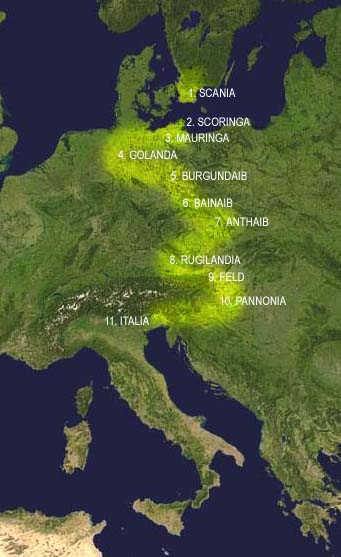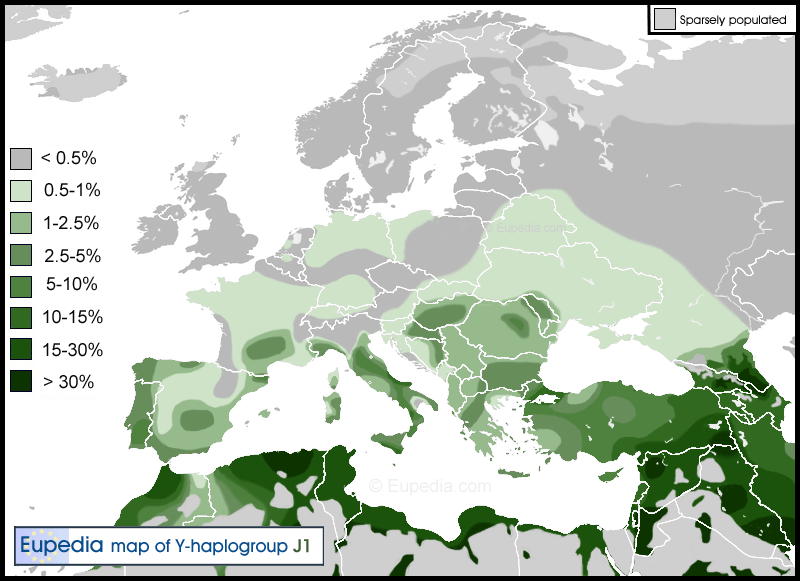Dorianfinder
Regular Member
- Messages
- 472
- Reaction score
- 49
- Points
- 28
- Location
- Western Cape
- Ethnic group
- European
- Y-DNA haplogroup
- R-FGC13617
- mtDNA haplogroup
- T2b1
This quote from Taranis made me think whether we may have missed something more recent in Italy's history that could account for high R1b-U152 levels. How certain are we that the Lombards were R1b-U106, HG I?

Lombard lands c.750-785
The Lombards could have carried more R1b-U152 than R1b-U106 if we consider for a moment their migration routes into Italy. I do not deny that there had already been a significant R1b-U152 presence in Italy before their arrival but the R1b-U152 homeland was on the Lombardic migratory route to Italy. What we find today in Northern Italy appears to correspond with a Lombard expansion with an almost bottle-neck on the Lombardy southern border where R1b-U152 frequencies are highest. This explains high R1b-U152 levels on the Sicilian north coast as it was a Lombard colony and resulted in turning Sicily into what later became an anti-papist stronghold with Swabian rulers and Lombard aristocracy.
The Lombards migrated along the following proposed route into Italy.
The Lombards were part of the Suebi and towards the end of the ancient Roman empire, the Suebi and Alamanni brushed aside Roman defenses and occupied Alsace, and from there Bavaria and Switzerland. A pocket remained in Swabia in southwest Germany.
Alsace and Southwest Germany, together with Switzerland and Bavaria all have elevated R1b-U152 when compared to the surrounding region.
Ignore the Scandinavian origin, it is based on a legend, no historical source verifies Scania as Lombard homeland. Strabo and Tacitus mention the Lombards settled near the mouth of the Elbe suggesting a sea-faring culture near Scoringa.
The Codex Gothanus writes the Lombards were subjected by the Saxons around 300AD, but rose up against the Saxons with their king Agelmund. In the second half of the 4th century, the Lombards left their homes and embarked on their migration. The migration is first documented as having begun at Scoringa, not Scania as indicated on the above map.

Maybe the Roman migration of R1b-U152 is not the answer, Iberia and other Roman areas have more J and almost no R1b-U152.
... if you look at the distribution in France and the British Isles versus the Iberian penninsula. Why is there more U152 in Britain than in Iberia? How is this possible if it's from the Romans?

Lombard lands c.750-785
The Lombards could have carried more R1b-U152 than R1b-U106 if we consider for a moment their migration routes into Italy. I do not deny that there had already been a significant R1b-U152 presence in Italy before their arrival but the R1b-U152 homeland was on the Lombardic migratory route to Italy. What we find today in Northern Italy appears to correspond with a Lombard expansion with an almost bottle-neck on the Lombardy southern border where R1b-U152 frequencies are highest. This explains high R1b-U152 levels on the Sicilian north coast as it was a Lombard colony and resulted in turning Sicily into what later became an anti-papist stronghold with Swabian rulers and Lombard aristocracy.
The Lombards migrated along the following proposed route into Italy.
There is hardly any u-152 in scania and northern Germany. Besides how long did they take to migrate
The Lombards were part of the Suebi and towards the end of the ancient Roman empire, the Suebi and Alamanni brushed aside Roman defenses and occupied Alsace, and from there Bavaria and Switzerland. A pocket remained in Swabia in southwest Germany.
Alsace and Southwest Germany, together with Switzerland and Bavaria all have elevated R1b-U152 when compared to the surrounding region.
Ignore the Scandinavian origin, it is based on a legend, no historical source verifies Scania as Lombard homeland. Strabo and Tacitus mention the Lombards settled near the mouth of the Elbe suggesting a sea-faring culture near Scoringa.
The Codex Gothanus writes the Lombards were subjected by the Saxons around 300AD, but rose up against the Saxons with their king Agelmund. In the second half of the 4th century, the Lombards left their homes and embarked on their migration. The migration is first documented as having begun at Scoringa, not Scania as indicated on the above map.

Maybe the Roman migration of R1b-U152 is not the answer, Iberia and other Roman areas have more J and almost no R1b-U152.
Last edited:


